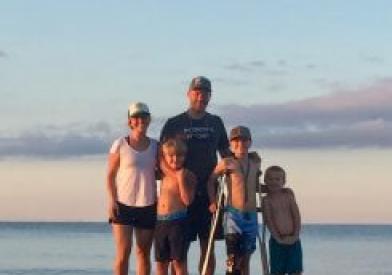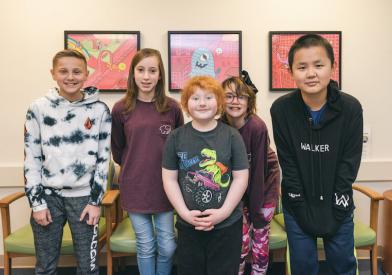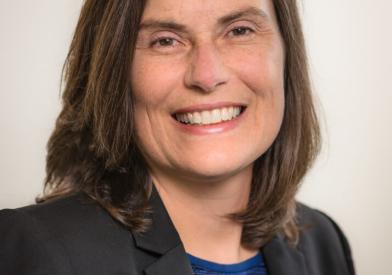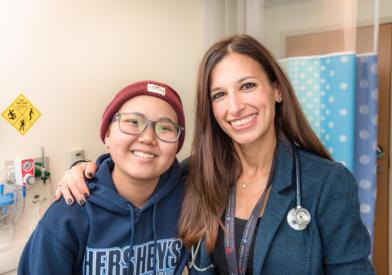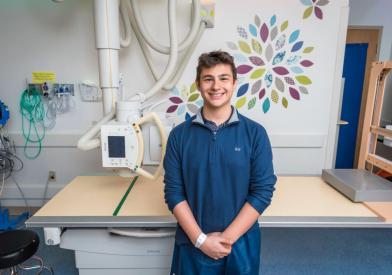What Is Osteosarcoma?
Osteosarcoma is the most common type of bone cancer among children, adolescents, and young adults. It usually occurs in the long bones of the arms or legs, but it can also happen in the pelvis and spine or, in rare cases, the jaw or other locations in the body.
- Osteosarcoma occurs most commonly in teenagers (when the rate of bone growth is the fastest). But it can affect young children and adults.
- There are about 600 new cases of osteosarcoma diagnosed each year in the United States.
- Osteosarcoma cancer cells can spread (metastasize) to other areas of the body. If this happens, it most often spreads to the lungs. It also can spread to other bones, and much less commonly, to the kidneys, adrenal gland, the brain, and heart.
- Some osteosarcoma types start just outside or at the bone's surface, instead of in the marrow cavity. These include:
- Parosteal osteosarcoma: Parosteal osteosarcoma originates in a layer of soft tissue next to the bone, most commonly in the thighbone. This type of osteosarcoma tends to occur in people between the ages of 20 and 40.
- Periosteal osteosarcoma: Periosteal osteosarcoma begins in the tough outer covering surrounding the bone that contains the blood vessels and nerves. It usually presents in the leg bone. It is more aggressive than parosteal osteosarcoma.
Dana-Farber/Boston Children's Cancer and Blood Disorders Center provides comprehensive and leading-edge care for children and adolescents with osteosarcoma. Our specialists in the Bone and Soft Tissue Tumors Program offer a level of expertise in bone cancers rarely seen at other pediatric cancer centers.
Causes and Symptoms of Osteosarcoma
In most cases, there is no apparent cause for osteosarcoma. However, genetics, abnormal bone metabolism, or environmental exposures are factors in some people. Possible causes may include:
- Inherited conditions that increase the risk of osteosarcoma are hereditary retinoblastoma, Li-Fraumeni syndrome, and Rothmund-Thomson, Bloom, and Werner syndromes.
- Bone diseases associated with an increased risk of osteosarcoma include Ollier's disease, osteogenesis imperfecta, polyostotic fibrous dysplasia, and Paget's disease.
- Radiation therapy for other types of cancer (such as Hodgkin lymphoma and non-Hodgkin lymphoma) increases the risk of osteosarcoma.
Osteosarcoma symptoms can vary depending on the tumor's size and location and whether it has spread. The most common symptoms include:
- Pain (sharp or dull) at the site of the tumor
- Swelling
- Redness at the site of the tumor
- Increased pain with activity or lifting
- Limping
- Decreased movement of the affected limb
Osteosarcoma symptoms may resemble other, more common conditions or medical problems. If you suspect that your child has osteosarcoma, consult your child's physician.
How We Diagnose Childhood Osteosarcoma
We use several diagnostic procedures to determine the type of tumor and whether it has spread. Your child's doctor will perform a complete medical and physical examination. They may also order several different tests, including advanced imaging studies, biopsy, and bone scan.
How We Treat Childhood Osteosarcoma
Osteosarcoma treatment may involve combining therapies, including chemotherapy, surgery, and radiation. In most cases, we use chemotherapy and surgery to treat children with osteosarcoma. However, treatment plans can vary depending on each child's situation.
Your child's treatment may include:
-
Chemotherapy: Osteosarcoma treatment often starts with chemotherapy. Chemotherapy is a group of drugs that interferes with the cancer cells' ability to grow or reproduce. It is a systemic treatment, meaning it is introduced to the bloodstream and travels throughout the body to kill cancer cells.
While chemotherapy can be quite effective in treating certain cancers, the drugs cannot tell the difference between normal healthy cells and cancer cells. Because of this, your child may experience adverse side effects during treatment. Understanding these side effects can help you, your child, and your care team prepare for and, in some cases, prevent these symptoms from occurring.
- Surgery: Depending on the tumor's size and location, and if it has spread, your child may receive one of the following surgical treatments:
- Limb-salvage surgery: We remove the tumor and healthy tissue surrounding the tumor while maintaining as much of the limb function as possible. Limb-salvage surgery can leave a leg or an arm fragile and increase the risk of fracture. Children need to avoid high-stress physical activities, such as skiing, skateboarding, and bike riding, to prevent fractures.
- Rotationplasty: This procedure is a partial amputation that preserves a cancer-free lower leg, attaches it to the thighbone, and uses the ankle as a knee joint. One of the significant benefits of rotationplasty is that children can have a very active lifestyle, including playing high-impact sports.
- Amputation: If we can't entirely remove the tumor because it involves the nerves and blood vessels, we may need to amputate a portion of the limb. If amputation is necessary, we will fit your child for a prosthesis following surgery.
- Rehabilitation: Rehabilitation and therapy are crucial parts of your child's osteosarcoma care. Our experienced physical and occupational therapists will work with your child after surgery to get them back to functioning in their daily life. If your child needs an amputation, Boston Orthotics & Prosthetics of Boston Children's Hospital will customize a prosthesis. Our physical therapists will help your child learn to use it effectively.
- Supportive care: We provide comprehensive care to keep your child comfortable during treatment. It involves preventing and treating infections, side effects of treatments, and complications.

